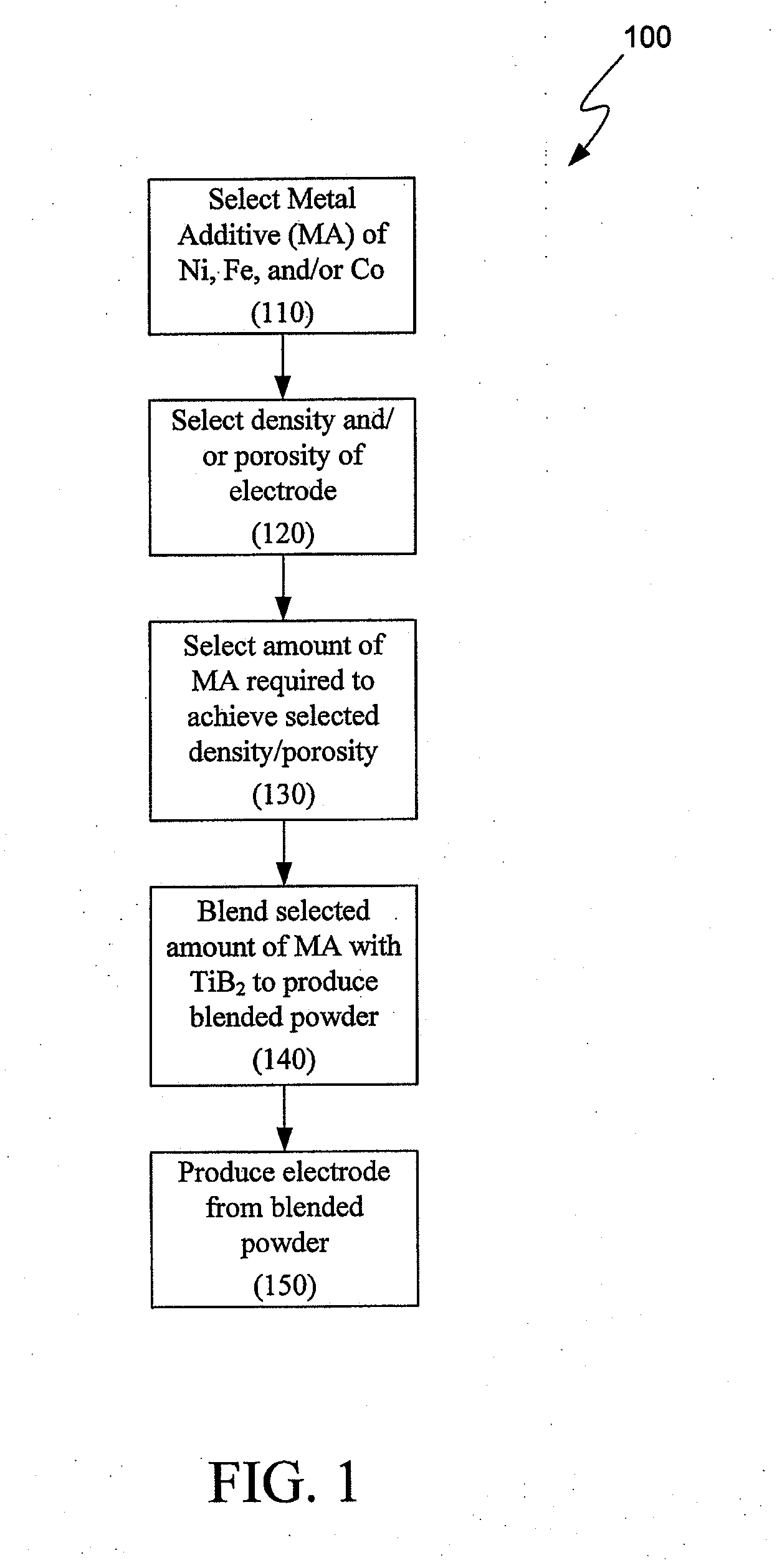Composition for making wettable cathode in aluminum smelting
a technology of aluminum smelting and wettable cathode, which is applied in the direction of basic electric elements, electrical equipment, conductive materials, etc., can solve the problems of unavoidable balance impurities, achieve the effect of facilitating sintering, facilitating production and use, and facilitating sintering
- Summary
- Abstract
- Description
- Claims
- Application Information
AI Technical Summary
Benefits of technology
Problems solved by technology
Method used
Image
Examples
example 1
[0027]Three different TiB2 powders having the chemical make-up identified in Table 1, below, are produced by blending TiB2 powders (e.g., via a V-blender) with various other powders (all values are approximate. Composition D is pure TiB2 powder containing no metal additives. Various plates are made from Compositions A-D by pressing the compositions into plate form using a commercial-scale hot-press.
TABLE 1Chemical Makeup of Plates A-DMaterial Composition Composition Composition Composition (wt. %)ABCDFe0.140.080.05NegligibleNi0.160.080.04NegligibleCo0.160.080.04NegligibleW0.490.310.16NegligibleTiB2 andBalanceBalanceBalanceBalanceUnavoidableImpuritiesAve. density98.9%98.2%94.9%68.8%(% of theoretical)Bulk density4.474.444.29 3.11(g / cc)Apparent0.070.090.1328.6 Porosity, %Total Metal0.95%0.55%0.29% 0%Additives (wt. %)
[0028]Plates made from compositions A-C are exposed to a molten salt bath of a 10,000 ampere pilot-scale aluminum electrolysis cell. The plates made from Composition A fa...
example 2
[0033]Similar to Example 1, various powder blends are produced by blending. The weight percent of the metal additives of the various blended samples are provided in Table 2, below, the balance being TiB2 and unavoidable impurities. TiB2 powder samples are pressed into plate form using a lab-scale, hot-press. After pressing, the plates are machined into test coupons (e.g., 2″×2″×0.5″).
TABLE 2Chemical Makeup of Samples 1-9Total MetalAve. DensityApparentMaterialAdd. (% ofPorositySample(weight %)(wt. %)theoret.)(%)Result10.125 Ni0.12597.20.09Pass2 0.25 Ni0.2598.50.23Pass30.063 Fe0.06388.93.79Pass40.125 Fe0.12597.00.10Pass5 0.25 Fe0.2598.00.05Pass6 0.50 Fe0.5098.80.12Fail7 0.6 W0.6061.937.2Fail80.5 Fe + 0.6 W1.199.60.07Fail90.05 each of Fe,0.3097.80.18PassNi, Co + 0.15W
[0034]The test coupons are exposed to a molten aluminum bath having a salt cover in an alumina crucible. The temperature of the molten aluminum was comparable to the conditions used in aluminum electrolysis cells employin...
PUM
| Property | Measurement | Unit |
|---|---|---|
| wt. % | aaaaa | aaaaa |
| wt. % | aaaaa | aaaaa |
| density | aaaaa | aaaaa |
Abstract
Description
Claims
Application Information
 Login to View More
Login to View More - R&D Engineer
- R&D Manager
- IP Professional
- Industry Leading Data Capabilities
- Powerful AI technology
- Patent DNA Extraction
Browse by: Latest US Patents, China's latest patents, Technical Efficacy Thesaurus, Application Domain, Technology Topic, Popular Technical Reports.
© 2024 PatSnap. All rights reserved.Legal|Privacy policy|Modern Slavery Act Transparency Statement|Sitemap|About US| Contact US: help@patsnap.com









